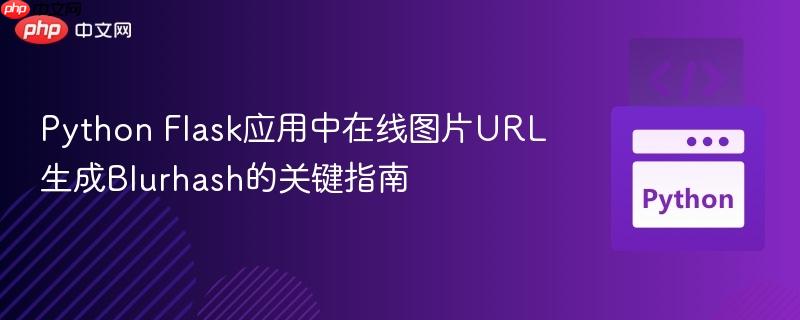
本教程旨在指导您如何在python flask应用程序中,将在线图片url转换为blurhash键。针对官方文档主要聚焦于本地文件处理的痛点,本文将详细介绍如何利用`requests`库获取远程图片数据,并结合`blurhash-python`库进行编码,最终提供一个完整的flask集成示例,帮助开发者高效处理网络图片资源。
Blurhash是一种紧凑的图片占位符编码格式,它能够生成一个短字符串,代表图片的模糊版本。在图片加载完成前,可以使用这个模糊占位符提升用户体验。blurhash-python是Blurhash的官方Python实现,它提供了将图片文件或字节流编码为Blurhash字符串的功能。
在开始之前,我们需要安装必要的Python库。除了Flask,我们还需要blurhash库来执行编码,以及requests库来下载在线图片。Pillow(PIL fork)虽然不是blurhash-python的直接强制依赖,但在处理图片时非常常用,建议一同安装,以便进行更灵活的图片操作(例如调整大小、格式转换等),尽管本教程主要关注其与blurhash的配合。
pip install Flask blurhash requests Pillow
blurhash-python库的encode方法通常接受一个文件对象或一个字节流作为输入。对于在线图片URL,核心挑战在于如何将远程图片内容转换为blurhash.encode可以处理的格式。这通常通过以下两个步骤完成:
使用requests库可以方便地从指定的URL下载图片的二进制内容。务必处理网络请求可能出现的错误,例如连接超时、URL无效或服务器返回非图片内容等。
立即学习“Python免费学习笔记(深入)”;
import requests
from io import BytesIO
def fetch_image_from_url(image_url: str) -> BytesIO | None:
"""
从给定的URL获取图片内容,并返回一个BytesIO对象。
"""
try:
response = requests.get(image_url, stream=True, timeout=10)
response.raise_for_status() # 检查HTTP响应状态码
# 验证内容类型,确保是图片
if not response.headers['Content-Type'].startswith('image/'):
print(f"URL {image_url} 返回的内容不是图片。")
return None
image_data = BytesIO(response.content)
return image_data
except requests.exceptions.RequestException as e:
print(f"从URL {image_url} 获取图片失败: {e}")
return None一旦我们获得了图片的二进制内容(例如,通过BytesIO对象),就可以将其直接传递给blurhash.encode函数。该函数需要两个关键参数:x_components和y_components,它们定义了Blurhash的水平和垂直分量数量,通常推荐使用4x3或5x4,具体取决于所需的细节程度。
import blurhash
from io import BytesIO
def generate_blurhash_from_image_data(image_data: BytesIO, x_components: int = 4, y_components: int = 3) -> str | None:
"""
从图片二进制数据生成Blurhash字符串。
"""
try:
# blurhash.encode 可以直接处理BytesIO对象
hash_key = blurhash.encode(image_data, x_components=x_components, y_components=y_components)
return hash_key
except Exception as e:
print(f"生成Blurhash失败: {e}")
return None现在,我们将上述逻辑整合到一个Flask应用中。创建一个路由,接收一个图片URL作为参数,然后调用我们的辅助函数来生成并返回Blurhash键。
from flask import Flask, request, jsonify
import requests
from io import BytesIO
import blurhash
from PIL import Image # 尽管blurhash不强制,但处理图片时Pillow很有用
app = Flask(__name__)
def fetch_image_from_url(image_url: str) -> BytesIO | None:
"""
从给定的URL获取图片内容,并返回一个BytesIO对象。
"""
try:
response = requests.get(image_url, stream=True, timeout=10)
response.raise_for_status() # 检查HTTP响应状态码
# 简单验证内容类型
content_type = response.headers.get('Content-Type', '')
if not content_type.startswith('image/'):
print(f"URL {image_url} 返回的内容不是图片: {content_type}")
return None
image_data = BytesIO(response.content)
# 尝试用Pillow打开以验证图片有效性,并确保其处于RGB模式
try:
img = Image.open(image_data)
if img.mode != 'RGB':
img = img.convert('RGB')
# 重置BytesIO的指针,以便blurhash库可以从头读取
image_data.seek(0)
return image_data
except Exception as e:
print(f"无法解析图片数据或转换为RGB: {e}")
return None
except requests.exceptions.RequestException as e:
print(f"从URL {image_url} 获取图片失败: {e}")
return None
def generate_blurhash_from_image_data(image_data: BytesIO, x_components: int = 4, y_components: int = 3) -> str | None:
"""
从图片二进制数据生成Blurhash字符串。
"""
try:
hash_key = blurhash.encode(image_data, x_components=x_components, y_components=y_components)
return hash_key
except Exception as e:
print(f"生成Blurhash失败: {e}")
return None
@app.route('/blurhash', methods=['GET'])
def get_blurhash():
image_url = request.args.get('url')
if not image_url:
return jsonify({"error": "请提供图片URL参数"}), 400
# 可以添加更严格的URL验证,例如使用urllib.parse或正则表达式
image_data = fetch_image_from_url(image_url)
if not image_data:
return jsonify({"error": "无法获取或处理图片"}), 500
blurhash_key = generate_blurhash_from_image_data(image_data)
if not blurhash_key:
return jsonify({"error": "无法生成Blurhash"}), 500
return jsonify({"blurhash": blurhash_key}), 200
if __name__ == '__main__':
# 示例用法:
# 启动应用后,访问 http://127.0.0.1:5000/blurhash?url=https://example.com/your-image.jpg
app.run(debug=True)如何运行此Flask应用:
通过结合requests库获取在线图片数据和blurhash-python库进行编码,我们成功解决了在Python Flask应用中从在线图片URL生成Blurhash键的问题。这个解决方案不仅填补了官方文档在处理远程资源方面的空白,还提供了一个健壮的框架,包含了错误处理和性能优化的考虑。在实际部署时,请务必根据您的应用场景进一步完善安全性、可伸缩性和容错机制。
以上就是Python Flask应用中在线图片URL生成Blurhash的关键指南的详细内容,更多请关注php中文网其它相关文章!

每个人都需要一台速度更快、更稳定的 PC。随着时间的推移,垃圾文件、旧注册表数据和不必要的后台进程会占用资源并降低性能。幸运的是,许多工具可以让 Windows 保持平稳运行。

Copyright 2014-2025 https://www.php.cn/ All Rights Reserved | php.cn | 湘ICP备2023035733号